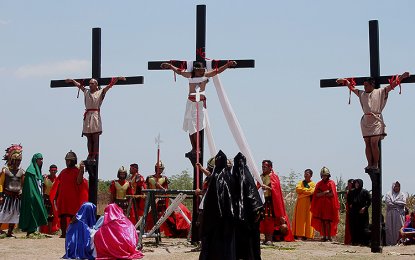
"Maleldo", a Kapampangan word for Holy Week, is highlighted with several penitents literally nailed to the wooden crosses in a makeshift Calvary in Barangay San Pedro Cutud and in two other villages, Sta. Lucia and San Juan, in Pampanga. (PNA file photo)
CITY OF SAN FERNANDO, Pampanga -- Lenten season is the traditional annual observance of the passion and death of Jesus Christ by Catholic devotees.
In many parts of the country, the Lenten season is usually observed through fasting, abstinence and penitence - as well as the staging of traditional passion plays or "senakulo," "Visita Iglesia" and the "Pabasa ng Pasion" (recitation and singing of the Passion of Christ).
But what makes the observance of Lenten season in Pampanga different from the others is the detailed re-enactment of the "Way of the Cross" (Via Crucis) and the sorrowful crucifixion and sufferings of Jesus Christ by local residents here.
Dubbed as "Maleldo", a Kapampangan word to Holy Week, the "Via Crucis" is highlighted with several penitents literally nailed to the wooden crosses in a makeshift Calvary in Barangay San Pedro Cutud and in two other villages, Sta Lucia and San Juan.
Prior to the actual nailing rites, thousands of penitents called "magdarame" (flagellants), will parade on the streets carrying wooden crosses and whipping their backs with bamboo stick called "burilyos."
At the end of their agonizing walk, some of the penitents will go to the man-made Calvary for the actual crucifixions.
Many of the penitents undergo the annual ritual to atone for their sins, pray for the sick or a better life, and give thanks for what they believe were God-given miracles.
Some of them do it for their families while others perform it as a commitment every Holy Week.
Each of the penitents interestingly has their own experiences to tell.
While the modern Catholic Church does not approve nor allow these acts, the penitents are unperturbed and their way of sacrifice even draw thousands of local and foreign pilgrims and spectators to the province - to witness the traditional "Via Crucis," which is on its 56th year.
Some 40,000 to 50,000 spectators are expected to troop to the crucifixion sites this coming Good Friday, City tourism officer Ching Pangilinan said.
This year, Pangilinan said that 13 penitents have expressed their willingness to be nailed on the wooden crosses.
He said the 57-year old painter Ben Enaje would once more play the role of Jesus Christ.
This will be the 32nd time that Enaje will be nailed on the cross as he continued to thank God after surviving a fall from a three-storey building while he was painting years ago.
The first crucifixions will be in Barangay San Juan at 6 a.m., followed by Barangay Sta. Lucia at 9 a.m. and Barangay San Pedro Cutud at 10 a.m.
Pangilinan said all the 13 penitents to be crucified on Good Friday are men who had been crucified before.
She also said that the local government unit of San Fernando would not be an active participant in the crucifixion rites and would just let the host barangays direct supervise the events.
She said the city government of San Fernando’s role is limited to peace and order and to ensure the health of the participants.
The re-enactment of Jesus Christ's crucifixion was originated in 1955 with the staging of "Via Crucis," the only Kapampangan piece on the passion of the Christ written by an amateur, Ricardo Navarro.
It was first performed during the Holy Week in 1955 by an amateur volunteer artist of Barangay San Pedro Cutud.
However, it was only in 1962 that the barangay first witnessed an actual crucifixion during the play. (PNA)
